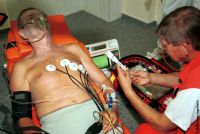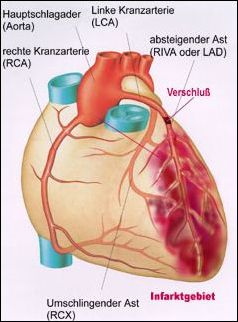
Heart Attack: Better Protection for High-Risk Patients
Human DNA consists of 23 pairs of chromosomes. NGFN scientists, together with German, British and French colleagues, analyzed the genetic data of nearly 3,000 patients and 4,500 healthy control persons from two independent genome-wide analyses with respect to coronary heart disease and myocardial infarction. To date it is the largest published study of its kind. The scientists identified several regions on the chromosomes which alone or in interaction with others can increase the risk for coronary heart diseases and heart attack.

Every year in Germany, approximately 280,000 people suffer a heart attack, and over 60,000 people die of an acute heart attack.
Figure: Boehringer Ingelheim
Figure: Boehringer Ingelheim
“Altogether, on different chromosomes we found seven genetic variants, each of which increase the risk for heart attack by between 20 to 30 percent,” said Professor Heribert Schunkert, director of Medical Clinic II of the University Hospital Schleswig-Holstein. “That shows how immensely complex cardiac diseases can be.” Moreover, for a genetic variant on chromosome 2, the researchers showed that the risk for heart attack due to this mutation also depends on additional factors such as overweight and hypertension. The disease is thus not only genetically induced – a healthy lifestyle is and remains a good prevention strategy.

The cause of heart attack is a severely narrowed or completely blocked coronary artery. The surrounding myocardial tissue (here colored red) does not get enough oxygen and nutrients and subsequently dies.
Figure: http://www.theheart.de
Figure: http://www.theheart.de
According to data of the Federal Office of Statistics, one in five deaths in Germany are due to coronary heart disease: fatty, calcified deposits block the coronary arteries and thus lead to a heart attack. In one of its genome networks (Cardiovascular Diseases), the National Genome Research Network, which is supported by the Federal Ministry of Education and Research (BMBF), is investigating the genetic causes of coronary heart disease. The findings from this research can possibly lead to new approaches for the prevention and treatment of this widespread disease.
University Schleswig-Holstein
Klinikum der Universität Regensburg
GSF-Nationales Forschungszentrum für Umwelt und Gesundheit




